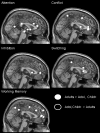The adolescent brain: insights from functional neuroimaging research
- PMID: 18383544
- PMCID: PMC2788780
- DOI: 10.1002/dneu.20615
The adolescent brain: insights from functional neuroimaging research
Abstract
With the development of functional neuroimaging tools, the past two decades have witnessed an explosion of work examining functional brain maps, mostly in the adult brain. Against this backdrop of work in adults, developmental research begins to gather a substantial body of knowledge about brain maturation. The purpose of this review is to present some of these findings from the perspective of functional neuroimaging. First, a brief survey of available neuroimaging techniques (i.e., fMRI, MRS, MEG, PET, SPECT, and infrared techniques) is provided. Next, the key cognitive, emotional, and social changes taking place during adolescence are outlined. The third section gives examples of how these behavioral changes can be understood from a neuroscience perspective. The conclusion places this functional neuroimaging research in relation to clinical and molecular work, and shows how answers will ultimately come from the combined efforts of these disciplines.
Figures





Similar articles
-
fMRI functional connectivity applied to adolescent neurodevelopment.Annu Rev Clin Psychol. 2015;11:361-77. doi: 10.1146/annurev-clinpsy-032814-112753. Epub 2015 Jan 2. Annu Rev Clin Psychol. 2015. PMID: 25581237 Free PMC article. Review.
-
Adolescent Brain Development: Implications for Understanding Risk and Resilience Processes Through Neuroimaging Research.J Res Adolesc. 2018 Mar;28(1):4-9. doi: 10.1111/jora.12379. J Res Adolesc. 2018. PMID: 29460349 Free PMC article.
-
Considerations for imaging the adolescent brain.Dev Cogn Neurosci. 2012 Jul;2(3):293-302. doi: 10.1016/j.dcn.2012.02.002. Epub 2012 Feb 27. Dev Cogn Neurosci. 2012. PMID: 22669033 Free PMC article. Review.
-
Understanding the Role of Puberty in Structural and Functional Development of the Adolescent Brain.J Res Adolesc. 2019 Mar;29(1):32-53. doi: 10.1111/jora.12408. J Res Adolesc. 2019. PMID: 30869842 Review.
-
Imaging brain development: the adolescent brain.Neuroimage. 2012 Jun;61(2):397-406. doi: 10.1016/j.neuroimage.2011.11.080. Epub 2011 Dec 8. Neuroimage. 2012. PMID: 22178817 Review.
Cited by
-
Brain and Cognitive Development in Adolescents with Anorexia Nervosa: A Systematic Review of fMRI Studies.Nutrients. 2019 Aug 15;11(8):1907. doi: 10.3390/nu11081907. Nutrients. 2019. PMID: 31443192 Free PMC article.
-
Feasibility of functional neuroimaging to understand adolescent women's sexual decision making.J Adolesc Health. 2015 Apr;56(4):389-95. doi: 10.1016/j.jadohealth.2014.11.004. Epub 2015 Jan 13. J Adolesc Health. 2015. PMID: 25595129 Free PMC article.
-
fMRI functional connectivity applied to adolescent neurodevelopment.Annu Rev Clin Psychol. 2015;11:361-77. doi: 10.1146/annurev-clinpsy-032814-112753. Epub 2015 Jan 2. Annu Rev Clin Psychol. 2015. PMID: 25581237 Free PMC article. Review.
-
The relationship between negative life events and cortical structural connectivity in adolescents.IBRO Neurosci Rep. 2024 Feb 1;16:201-210. doi: 10.1016/j.ibneur.2024.01.012. eCollection 2024 Jun. IBRO Neurosci Rep. 2024. PMID: 38348392 Free PMC article.
-
The influence of emotion on cognitive control: relevance for development and adolescent psychopathology.Front Psychol. 2011 Nov 25;2:327. doi: 10.3389/fpsyg.2011.00327. eCollection 2011. Front Psychol. 2011. PMID: 22275904 Free PMC article.
References
-
- Adleman NE, Menon V, Blasey CM, White CD, Warsofsky IS, Glover GH, Reiss AL. A developmental fMRI study of the Stroop color-word task. Neuroimage. 2002;16:61–75. - PubMed
-
- Adolphs R. Is the human amygdala specialized for processing social information? Ann N Y Acad Sci. 2003;985:326–340. - PubMed
-
- Andersen SL. Trajectories of brain development: Point of vulnerability or window of opportunity? Neurosci Biobehav Rev. 2003;27:3–18. - PubMed
-
- Angold A, Costello EJ, Erkanli A, Worthman CM. Pubertal changes in hormone levels and depression in girls. Psychol Med. 1999;29:1043–1053. - PubMed
-
- Arnold LE, Zametkin A, Caravella L, Korbly N. Ethical issues in neuroimaging research with children. In: Ernst M, Rumsey JM, editors. Functional neuroimaging in child psychiatry. Cambridge, UK: Cambridge University Press; 2000. pp. 99–109.
Publication types
MeSH terms
Grants and funding
LinkOut - more resources
Full Text Sources
Medical
Miscellaneous

